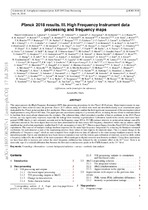| dc.contributor.author | Akrami, Yashar | |
| dc.contributor.author | Arroja, Frederico | |
| dc.contributor.author | Ashdown, Mark A.J. | |
| dc.date.accessioned | 2020-11-06T11:23:48Z | |
| dc.date.available | 2020-11-06T11:23:48Z | |
| dc.date.issued | 2020 | |
| dc.identifier.citation | Akrami, Y. et al. (2020). Planck 2018 results: III. High frequency instrument data processing and frequency maps.Astronomy and Astrophysics 641,A3. Doi: https://doi.org/10.1051/0004-6361/201832909 | en_US |
| dc.identifier.issn | 1432-0746 | |
| dc.identifier.uri | http://hdl.handle.net/10566/5377 | |
| dc.description.abstract | This paper presents the High Frequency Instrument (HFI) data processing procedures for the Planck 2018 release. Major improvements in mapmaking have been achieved since the previous Planck 2015 release, many of which were used and described already in an intermediate paper
dedicated to the Planck polarized data at low multipoles. These improvements enabled the first significant measurement of the reionization optical
depth parameter using Planck-HFI data. This paper presents an extensive analysis of systematic effects, including the use of end-to-end simulations
to facilitate their removal and characterize the residuals. The polarized data, which presented a number of known problems in the 2015 Planck
release, are very significantly improved, especially the leakage from intensity to polarization. Calibration, based on the cosmic microwave background (CMB) dipole, is now extremely accurate and in the frequency range 100 to 353 GHz reduces intensity-to-polarization leakage caused by
calibration mismatch. | en_US |
| dc.language.iso | en | en_US |
| dc.publisher | EDP Sciences | en_US |
| dc.subject | Cosmology | en_US |
| dc.subject | Observations | en_US |
| dc.subject | Cosmic background radiation | en_US |
| dc.subject | Surveys | en_US |
| dc.subject | Data analysis | en_US |
| dc.title | Planck 2018 results: III. High frequency instrument data processing and frequency maps | en_US |
| dc.type | Article | en_US |

